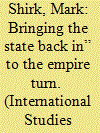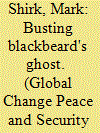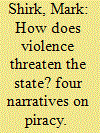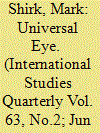|
|
|
Sort Order |
|
|
|
Items / Page
|
|
|
|
|
|
|
| Srl | Item |
| 1 |
ID:
155315


|
|
|
|
|
| Summary/Abstract |
Through most of the seventeenth century, European states used an “imaginary” boundary in the Atlantic referred to as “the line” to cordon off the affairs of Europe from those in the New World. The line structured colonial rule, captured in the phrase “there is no peace beyond the line.” However, by the middle of the eighteenth century, the idea of “the line” no longer held. Common explanations ranging from the rise of capitalism, technology, and interstate competition do not explain this shift. Instead, I argue that the “golden age of piracy” was instrumental. In giving this explanation, I argue that the empire turn in IR has under-theorized the tensions between state and empire in the modern era. I introduce the state–empire hybrid polity as one that is constantly mediating the tensions between the difference characteristic of empire and the integration of the state. “The line” was how European states mediated this tension in the seventeenth century. Pirates took advantage of the open markets and ungoverned spaces inherent in the line, causing a crisis in colonial rule. To defeat piracy and make the world safe for trade, these tensions needed to be remediated and “the line” transformed. As an unintended consequence, this put further strain on England’s North American empire.
|
|
|
|
|
|
|
|
|
|
|
|
|
|
|
|
| 2 |
ID:
143655


|
|
|
|
|
| Summary/Abstract |
Despite renewed interest, one area of piracy studies that can be improved is that of historical comparison. Most studies operate under the belief that piracy is an action similar enough to be compared across time and space. Yet piracy is a socially constructed concept that only has meaning within a narrative and most ‘waves’ of piracy are characterized by more than one narrative. Thus, comparing all acts of piracy across time and space necessarily means accepting a particular narrative about piracy as true. Much historical-comparative work on piracy compares contemporary piracy to that of the ‘golden age’ of piracy in the eighteenth century. By focusing on the narratives of both pirates and counter-pirates, piracy in Southeast Asia in the nineteenth century is more comparable to contemporary piracy in the Gulf of Aden. Both ‘waves’ were characterized by competing narratives of pirates defending local interests vs. the counter-piracy narratives of criminality. This approach highlights similar dynamics in each that can help researchers and policymakers make sense of piracy in the twenty-first century. In particular both ‘waves’ were characterized by the rise of local political formations built around piracy and the denial of the political content of piracy by counter-pirates.
|
|
|
|
|
|
|
|
|
|
|
|
|
|
|
|
| 3 |
ID:
156898


|
|
|
|
|
| Summary/Abstract |
Violence characterized by similar actions, actor motivations, group structures, or level of damage still poses qualitatively distinct genera of threats to states. For instance, “terrorism” can threaten a particular state, be used by a state, or threaten the entire state system. Building on the threat construction literature, this study argues that threat is best understood through narratives on the relationship between violence and the boundary-producing practices that construct the state. Four ideal-typical basic narratives on this relationship are produced—entrant, resource, revisionist, and criminal. Each narrative is then demonstrated by looking at how it was used in a historical case of piracy. The action (piracy as raiding at sea) is held constant while the threat in each varies with the narrative. Understanding how threat is narratively constructed can help us to understand particular historical episodes of violence and state responses to them.
|
|
|
|
|
|
|
|
|
|
|
|
|
|
|
|
| 4 |
ID:
167433


|
|
|
|
|
| Summary/Abstract |
Recent controversies over bulk data collection remind us of the importance of surveillance as a site of citizen-state interaction. Surveillance is intimately linked to the nature and scope of the state, but receives comparatively little attention in traditional work on state formation. I show that the modern surveillance state emerged as a reaction to anarchist “propaganda of the deed,” which entailed assassinations of political leaders, as well as bombings of cafes, theatres, and landmarks. I theorize this mutation through a practice conception of state institutions, one that focuses on processes of boundary maintenance and transformation. I argue that boundary “shattering” constitutes an important mechanism of state transformation, one in which events or processes render existing boundary-drawing practices useless. The ensuing crisis requires the state to “reinscribe” new boundaries through the development of new practices.
|
|
|
|
|
|
|
|
|
|
|
|
|
|
|
|
|
|
|
|
|